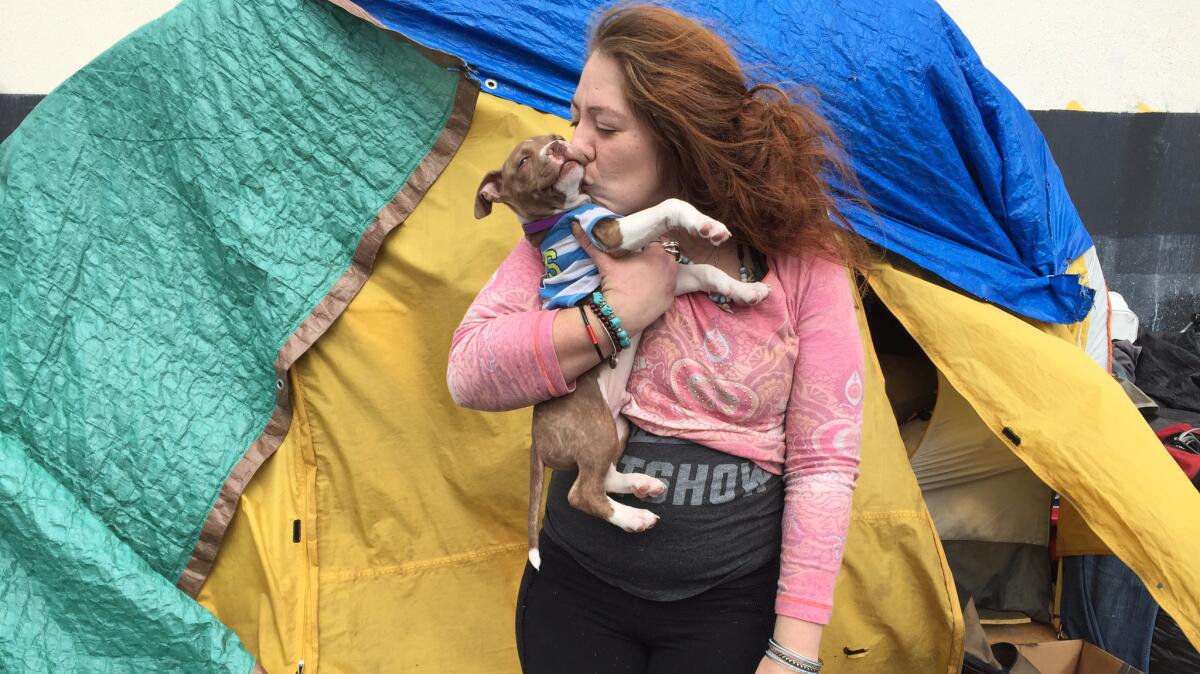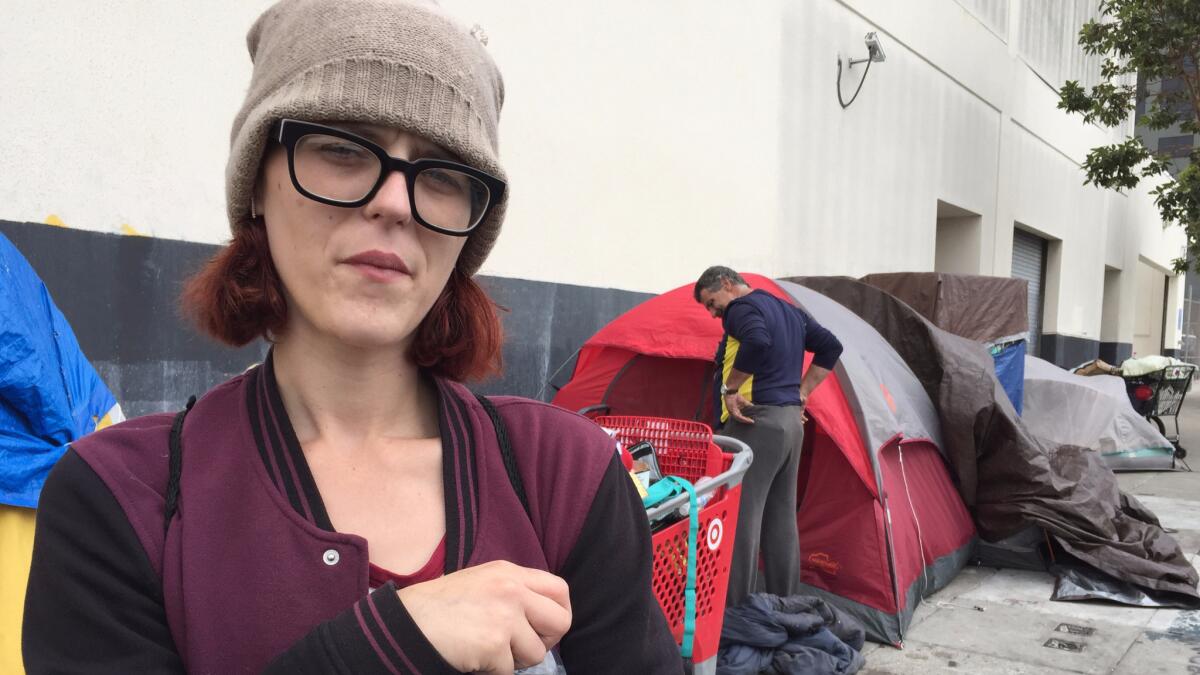Column: In San Francisco, a coordinated media effort to solve homelessness stirs the city

- Share via
Reporting from San Francisco — The wind whipped at blue plastic tarps protecting Andi Montoya’s tented home, a mattress-topped wood platform on two giant Costco flat shopping carts, easy to roll if the cops force her to move.
As tough as it is on the sidewalk — no toilet, no shower, no trash collection — Montoya and her husband, Greg, get by. They’ve managed to hang on to this piece of concrete on Florida Street south of Market for eight months. A medical van comes on Tuesdays. Church groups provide sack lunches, sometimes hot food. The SPCA, just across the street, gives them kibble for Hazelnut, their 10-week-old puppy.
The couple are on a waiting list for one of the city’s two Navigation Centers, a new kind of shelter that provides an array of support services to homeless people without restrictions like curfews, or prohibitions against keeping belongings or animals.
Yes, of course, Montoya said, she would rather live in a house. “But honestly? I have my soul mate, the love of my life, here. I’m happy with him wherever I am.”
I visited Montoya and some of her neighbors Wednesday, the day that dozens of normally competitive news organizations — papers, magazines, websites, radio and television stations — planned to saturate the Bay Area with stories, programs and commentary about homelessness.
“I had not heard about that,” Montoya said, “but it’s brilliant.”
::
On the Streets: A 12-part video series about homelessness in Southern California »

If nothing else, the SF Homeless Project was a fantastic deluge of information.
Morning, noon and night Wednesday, every time I looked at TV, or my computer, there was another story about homelessness, the great, draining conundrum of our times.
Instead of coming off as hand-wringing — or overkill — it felt like a great force was shaking the city’s shoulders: Wake up, people. This is not an unsolvable problem. It can be fixed.
The San Francisco Chronicle, which led the effort, posted stories from dozens of competing outlets on its Ending Homeless page at SF Gate.
The Chronicle’s lead story Wednesday proposed a simple-sounding but complex solution for the 6,600 or so homeless people in the city, an estimated 1,500 of whom are considered “hard core” street people: Get them into supportive housing.
Staff writer Kevin Fagan, who spent four months living as a homeless person in 2003 for a series about life on the streets, estimated it would cost $200 million to build enough units, and $50 million a year in operating expenses. (This year alone, out of an $8.9-billion budget, San Francisco will spend about $241 million on its homeless citizens, not including police and emergency medical services.)
In the evening, top editors of the Chronicle, Mother Jones, KQED public media and San Francisco magazine gathered at the Commonwealth Club for a sold-out public conversation about the project.
Chronicle Editor in Chief Audrey Cooper said the idea hit her while she was leading one of her monthly newsroom tours, and a visitor suggested the paper write a story about ending homelessness. “I felt like I’d been punched,” Cooper said. “We do stories like that every week!”
She remembered a conversation she’d had with Clara Jeffery, editor in chief of Mother Jones, who had once suggested over beers with Cooper and Matt Honan, Buzzfeed’s San Francisco bureau chief, that they collaborate on a story about a particular politician.
“That would blow people’s minds,” Jeffery said.
It took a few meetings, and months of planning, said Holly Kernan, KQED’s executive news editor, but journalists were surprisingly willing to abandon their traditional competitive streaks.
“The enthusiasm was insane,” Kernan said. “We’ve been covering this for decades, and you just feel like you are stepping over somebody who is lying in the street and you are becoming inured to this crisis, and it feels intractable because it’s been going on for so long.”
Eventually, 70 outlets signed on. There was no coordination of stories.
The San Francisco Examiner focused on an elderly homeless man whose Parkinson’s medication and walker had been confiscated and destroyed by the Department of Public Works. KTVU TV ran a story about a mentally ill homeless man whose life changed dramatically once he decided to accept treatment. KQED radio host Michael Krasny spent his two-hour morning program talking to homeless people and their advocates. So did KALW’s Rose Aguilar. Buzzfeed posted an interactive story, “Can you find a place to sleep tonight?”
On Wednesday, San Francisco Mayor Ed Lee, who created a Department of Homelessness and Supportive Housing, presided over the opening of the city’s second Navigation Center, ahead of schedule.
U.S. Sen. Dianne Feinstein, a former San Francisco mayor, tweeted up a storm.
In Sacramento, lawmakers from San Francisco and Los Angeles asked Gov. Jerry Brown to declare a statewide homeless emergency, and state legislators sent a $2-billion bond measure to Brown that would provide housing for homeless Californians with mental illness. (The homeless crisis in Los Angeles, as my colleagues Gale Holland and Steve Lopez have relentlessly reported, is among the worst in the nation. The homeless population in L.A. dwarfs that of San Francisco, and yet because L.A.’s chronically homeless are ghettoized, mostly, on skid row, the problem is easier to ignore than in this far more compact city.)
“This week,” Cooper said, “you have seen more politicians saying the word ‘homelessness’ than you have heard for the last four years.”
Sunday, she said, the Chronicle’s front page will be taken up by one long, uninterrupted editorial about homelessness and a tiny photo. “You’re going to see a lot of words, and it’s going to be scary and I don’t care. Sometimes you need to get in people’s faces and tell them what they need to know.”
[email protected] @AbcarianLAT
ALSO
1 in 10 Cal State students is homeless, study finds
Los Angeles may pass new ban on homeless people living in cars
LAPD orders officers to show ‘compassion and empathy’ to homeless people







